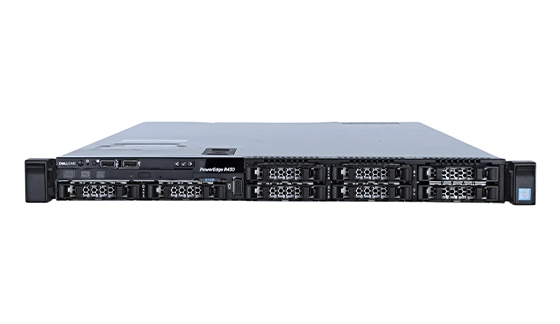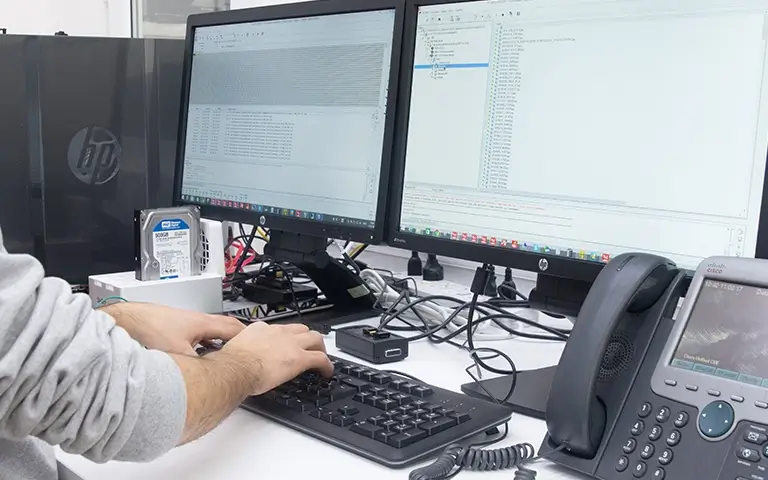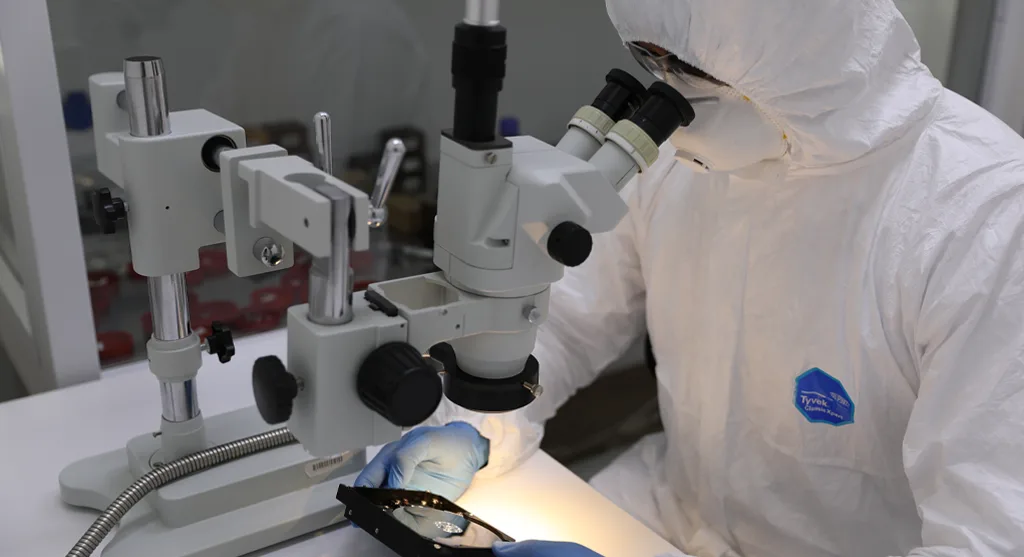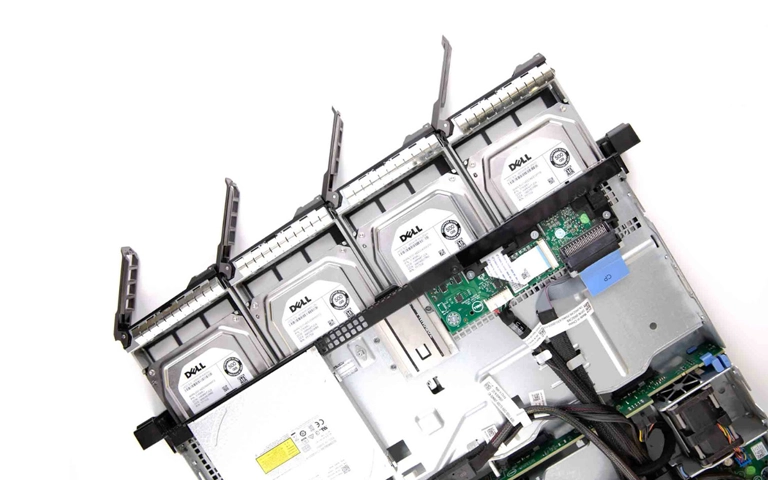Last month, our engineers received a Dell PowerEdge R430 server configured with four hard drives in a RAID 10 array. The system ran on Linux Logical Volume Manager (LVM), which allowed the client to organize storage efficiently for business operations.
The server had performed reliably for years until a power surge caused the system to shut down unexpectedly.
After the incident, the device would no longer start, and attempts to access the disks on other computers failed. The drives were not visible in the BIOS, and the only sign of life was a continuous beeping sound coming from the system.
Because the server contained critical business data, the client decided to reach out to RAID Recovery Services for an expedited evaluation and professional recovery.

Power Surge and Initial Symptoms
The client explained that the failure occurred right after a sudden power supply malfunction. When he attempted to restart the Dell PowerEdge server, the fans turned on, but the drives were not detected by the system. A continuous beeping noise indicated that multiple components had been damaged.
He removed the drives and tested them individually on different computers, yet none appeared in the BIOS.
These symptoms clearly suggested that the power surge had affected the drives’ electronic boards, making them unreadable by any standard interface.
Realizing the issue was beyond software repair, the client decided to stop all recovery attempts and contact our engineers for professional assistance.
To better understand how sudden electrical failures can cause severe data loss, visit Reasons for RAID Data Loss.
Consultation and Expedited Evaluation
After contacting our support team, the client opted for an expedited evaluation service to minimize downtime.
We immediately provided detailed shipping instructions and a prepaid label to ensure the safe transportation of the Dell PowerEdge server to our recovery lab.
Once received, our engineers began the inspection process following a structured diagnostic protocol.
Our evaluation process included:
Physical examination: Inspecting the server chassis and internal components for visible damage.
Drive testing: Checking all four hard drives individually to identify electrical or mechanical issues.
Power supply verification: Confirming the malfunction of the original power unit and ruling out controller faults.
Preparation for cleanroom inspection: Isolating damaged drives for further analysis under controlled conditions.
The assessment confirmed that the drives had suffered electrical damage consistent with a power surge. This required cleanroom procedures before recovery could begin.
For related cases involving electronic failure, see RAID Controller Failure Recovery.

Cleanroom Inspection and Findings
After confirming the electrical damage, our engineers transferred the drives to our ISO Certified Class 10 Cleanroom for detailed inspection.
Working in a controlled environment prevents contamination and allows precise handling of delicate drive components.
Inside the cleanroom, each hard drive was carefully unsealed and examined. The visual inspection revealed burn marks and damaged electronic components on the printed circuit boards (PCBs) of all four drives.
These findings were consistent with the effects of a power surge, which often destroys circuits and prevents the platters from spinning.
Our specialists compared the damaged components with serviceable ones from our inventory. For experienced technicians, the appearance of burned or swollen elements is enough to diagnose failure types and identify which parts require replacement.
Based on these observations, our team concluded that all drives had failed PCBs and would require replacement or repair before data recovery could proceed.
To understand how similar hardware damage affects RAID systems, read Troubleshoot RAID Failure.

Professional RAID 10 Recovery Process
Once the faulty electronic components were repaired, our engineers began the recovery procedure using a systematic and secure approach. Every step was designed to maintain data integrity and prevent further damage to the restored drives.
Steps in our recovery process:
Created bit-level copies of all repaired drives to work only with safe duplicates.
Determined the correct disk order, block size, and RAID controller algorithm to rebuild the RAID 10 structure.
Mounted the array in read-only mode to ensure no data was modified during recovery.
Examined Logical Volume Manager (LVM) metadata to restore the logical structure of the Linux file system.
Retrieved user files, project data, and configuration logs from the recovered array.
Confirmed file integrity and ensured all extracted data matched the client’s original directory layout.
This controlled and detailed method allowed our team to rebuild the damaged array successfully and recover nearly all data from the Dell PowerEdge R430 server.
For similar recovery processes, see How to Repair Degraded RAID and RAID File System.
Results and Data Verification
After reconstructing the array and extracting the data, our engineers verified the recovered files to ensure their integrity. The entire directory structure, including system folders and project files, was successfully restored from the Dell PowerEdge R430 RAID 10 configuration.
To confirm the results, we arranged a remote file verification session with the client. Using secure access, he reviewed the recovered data and confirmed that all critical files were present and accessible. This verification confirmed a high recovery success rate, meeting the client’s expectations.
Once the verification was complete, we transferred the recovered data to a new, stable storage device provided by the customer. The client was relieved to regain access to his critical business data, ensuring the continuity of his operations without any loss of valuable information.

Recover Data from Your Dell PowerEdge Server
At RAID Recovery Services, we specialize in restoring data from complex Dell PowerEdge RAID systems affected by power surges, mechanical failures, and electronic damage.
Our engineers combine advanced recovery tools with cleanroom technology to ensure maximum safety and precision throughout the process.
Whether your Dell server runs on RAID 10, RAID 5, or RAID 6, we can rebuild damaged arrays, repair failed drives, and recover data securely.
Every recovery is performed using verified drive images and read-only procedures to maintain data integrity.
If your Dell PowerEdge server fails to boot, makes unusual noises, or displays missing drives in the BIOS, turn it off immediately and contact our specialists.
Our team will evaluate your case, provide a recovery plan, and help you restore your system quickly and safely.
Trust the experts with proven results
Frequently Asked Questions
What causes a Dell PowerEdge RAID 10 server to fail?
RAID 10 servers can fail due to power surges, overheating, or hardware component damage. Electrical breakdowns often damage the drive PCBs or RAID controller, leading to unreadable disks and data loss.
Can a power surge damage all drives in a RAID array?
Yes. When a surge occurs, the electrical current can reach every connected drive simultaneously, damaging their circuit boards. In such cases, immediate power-off and professional evaluation are essential to prevent further loss.
How do professionals recover data from a RAID 10 array?
Experts clone each drive, determine the RAID order, and reconstruct the array in read-only mode. This method ensures no overwriting occurs and that data can be safely extracted and verified.
What should I do if my Dell PowerEdge server stops booting?
Do not continue restarting or testing the system. Power it down and contact a professional recovery team. Continued attempts can worsen component damage and make recovery more complex or impossible.